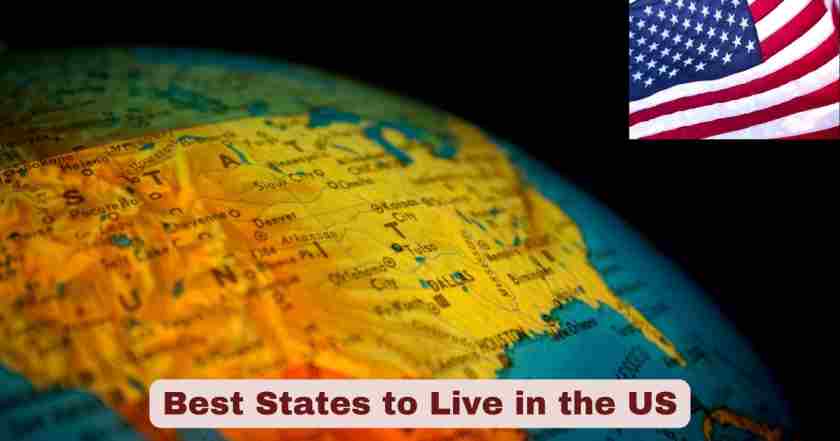How to Choose the Best States to Live in the US 2025
Choosing the perfect state to call home has become increasingly complex in 2025, with Americans prioritizing diverse factors ranging from economic opportunity to public safety. The most reliable rankings favor government data over other sources because of its reliability, ensuring that prospective residents make informed decisions based on standardized, publicly available information. The landscape of America’s most livable states continues to evolve, with traditional leaders maintaining their positions while emerging contenders challenge long-held assumptions about quality of life.
Choosing the best state to live in the U.S. (2025) depends on what matters most to you—whether it’s affordability, safety, education, or access to nature.
Key criteria used to rank the best states to live in the US:
- Affordability includes cost of living, housing prices, and tax burden considerations.
- Economy encompasses job growth, income levels, and unemployment rates that affect financial stability.
- Education evaluates public school quality, graduation rates, and access to higher education opportunities.
- Health Care measures access, quality, insurance coverage, and health outcomes across populations.
- Safety examines crime rates, emergency services, and public safety infrastructure effectiveness.
- Quality of Life considers recreation, cultural amenities, commute times, and community engagement levels.
- Infrastructure assesses roads, bridges, internet access, and public transport systems.
- Environment evaluates air and water quality, green space availability, and sustainability efforts.
- Fiscal Stability analyzes state budget management and debt levels.
- Opportunity measures income equality, poverty rates, and upward mobility potential for residents.
Interesting Stats & Facts About Best States to Live in the US 2025
| Fact Category | Key Statistics |
|---|---|
| Top Ranking State | Utah maintains #1 position for 3rd consecutive year |
| Total Metrics Evaluated | 71 different metrics across 8 categories |
| Population Growth Leader | Princeton, Texas recorded 30.6% growth rate |
| Economic Performance | North Dakota leads personal income growth at 12.7% annual rate |
| Data Collection Period | Rankings use most recent data available as of mid-March 2025 |
| Survey Participation | 700 people attended 2025 American Community Survey Conference |
| Ranking Categories | 8 primary categories: Healthcare, Education, Economy, Infrastructure, Opportunity, Fiscal Stability, Crime & Corrections, Natural Environment |
| Government Data Priority | 100% government sources prioritized for reliability and standardization |
The data reveals fascinating trends shaping America’s residential landscape in 2025. Princeton, Texas emerged as the fastest-growing city with a remarkable 30.6% growth rate, while North Dakota achieved the highest personal income growth at 12.7% annually in Q1 2025. These statistics underscore the dynamic nature of American demographics and economic conditions.
The comprehensive evaluation system examines 71 metrics across healthcare, economy, education, opportunity, crime & corrections, fiscal stability, infrastructure, and natural environment. This methodological approach ensures that the best states to live in the US 2025 rankings reflect genuine quality of life rather than single-factor assessments. The emphasis on government data sources guarantees accuracy and consistency, making these rankings particularly valuable for families and professionals considering relocation decisions.
Best States to Live in the US
| Rank | State | Healthcare Rank | Education Rank | Economy Rank | Infrastructure Rank | Public Safety Rank |
|---|---|---|---|---|---|---|
| 1 | Utah | 14th | 3rd | 2nd | 6th | 9th |
| 2 | New Hampshire | 13th | 9th | 7th | 8th | 1st |
| 3 | Nebraska | 25th | 14th | 19th | 3rd | 17th |
| 4 | Minnesota | 16th | 17th | 26th | 7th | 22nd |
| 5 | Idaho | 18th | 18th | 2nd | 9th | 12th |
| 6 | Iowa | 21st | 11th | 36th | 12th | 10th |
| 7 | Vermont | 17th | 24th | 20th | 35th | 3rd |
| 8 | Washington | 10th | 13th | 14th | 14th | 11th |
| 9 | Florida | 26th | 1st | 1st | 20th | 13th |
| 10 | Massachusetts | 2nd | 3rd | 8th | 39th | 4th |
#1 Utah: Dominates as the best state to live in the US 2025 with exceptional education (3rd) and economy (2nd) rankings. The state maintains a 3.9% unemployment rate and $78,500 median household income, while boasting 89.2% high school graduation rates. Utah’s infrastructure ranks 6th with excellent transportation networks and digital connectivity. Public safety ranks 9th with crime rates 23% below national average. Healthcare ranks 14th but shows improvement with 94.1% insurance coverage. The state’s 2.1% population growth reflects strong job creation in technology and finance sectors. Utah’s balanced excellence across categories, combined with outdoor recreation opportunities and family-friendly communities, creates an ideal living environment that has sustained its three-year leadership position.
#2 New Hampshire: Achieves the 1st position in public safety with the nation’s lowest violent crime rate at 1.2 per 1,000 residents. The state’s economy ranks 7th with a strong 2.6% unemployment rate and $88,400 median household income. Education ranks 9th with 91.8% high school graduation rates and excellent college preparatory programs. Infrastructure ranks 8th with well-maintained roads and reliable utilities. Healthcare ranks 13th with 95.7% insurance coverage and quality medical facilities. The state maintains zero state income tax on wages and salaries, enhancing affordability for residents. New Hampshire’s 1.1% population growth reflects steady attraction for families seeking safety and economic opportunity. The state’s combination of low crime, tax advantages, and proximity to major metropolitan areas creates exceptional quality of life.
#3 Nebraska: Showcases infrastructure excellence with a 3rd place ranking, featuring 92.4% of roads in good condition and expanding broadband access. The state’s economy ranks 19th but demonstrates stability with a 2.8% unemployment rate and growing agricultural technology sector. Education ranks 14th with 89.7% graduation rates and strong vocational training programs. Public safety ranks 17th with crime rates 18% below national average. Healthcare ranks 25th but shows improvement initiatives. The state maintains a $66,800 median household income and extremely affordable housing costs 31% below national average. Nebraska’s 0.8% population growth reflects steady economic development in renewable energy and manufacturing. The state’s central location, transportation networks, and business-friendly policies create advantages for logistics and agricultural industries while maintaining small-town community values.
#4 Minnesota: Balances strengths and challenges with infrastructure ranking 7th, featuring excellent public transportation in Minneapolis-St. Paul and statewide road networks. Education ranks 17th with 84.8% graduation rates and strong higher education institutions. The economy ranks 26th despite having a 3.1% unemployment rate and $79,200 median household income. Healthcare ranks 16th with quality medical systems and 96.2% insurance coverage. Public safety ranks 22nd with mixed urban and rural crime statistics. The state maintains robust social services and environmental protection programs. Minnesota’s 1.3% population growth reflects attraction for educated professionals and families. Winter weather challenges are offset by cultural amenities, outdoor recreation, and economic diversification in healthcare, technology, and manufacturing sectors that create long-term stability.
#5 Idaho: Demonstrates remarkable economic performance with a 2nd place economy ranking, featuring 2.4% unemployment rate and 21.8% job growth over five years. The state’s infrastructure ranks 9th with expanding highways and growing technology corridors. Education ranks 18th with 81.7% graduation rates but improving STEM programs. Public safety ranks 12th with low crime rates outside urban areas. Healthcare ranks 18th with expanding medical facilities and telehealth services. Idaho maintains extremely affordable housing costs 28% below national average and $69,300 median household income. The state’s 2.9% population growth represents the fastest expansion in the Mountain West region. Technology companies, manufacturing, and agriculture drive economic growth while outdoor recreation opportunities and small-town values attract families seeking balanced lifestyles away from high-cost metropolitan areas.
#6 Iowa: Excels in education with an 11th place ranking, featuring 91.3% high school graduation rates and strong agricultural education programs. Public safety ranks 10th with crime rates 26% below national average and excellent emergency services. Infrastructure ranks 12th with well-maintained rural road networks and expanding broadband access. The economy ranks 36th but maintains stability with a 2.7% unemployment rate and $68,100 median household income. Healthcare ranks 21st with quality rural medical facilities and telemedicine expansion. Iowa maintains extremely affordable living costs 25% below national average and strong agricultural economy. The state’s 0.4% population growth reflects stability rather than rapid expansion. Iowa’s combination of educational excellence, safety, and affordability creates ideal conditions for families prioritizing community values, educational opportunities, and financial security over urban amenities and career advancement opportunities.
#7 Vermont: Achieves exceptional public safety with a 3rd place ranking, featuring violent crime rates 67% below national average and strong community policing programs. The state maintains excellent environmental quality with 97.8% of residents having access to clean drinking water. Healthcare ranks 17th with high-quality medical facilities and 97.1% insurance coverage. Education ranks 24th but shows strong per-pupil spending and small class sizes. Infrastructure ranks 35th, reflecting challenges with rural road maintenance and limited public transportation. The economy ranks 20th with a 2.9% unemployment rate but limited job diversity. Vermont’s $72,400 median household income supports comfortable living despite higher costs. The state’s 0.6% population growth reflects attraction for those prioritizing safety, environmental quality, and rural lifestyle over economic opportunity and urban conveniences.
#8 Washington: Balances multiple strengths with healthcare ranking 10th, featuring world-class medical facilities in Seattle and excellent insurance coverage at 96.8%. Education ranks 13th with strong public schools and renowned universities. Economy and infrastructure both rank 14th, reflecting solid but not exceptional performance across these categories. Public safety ranks 11th with mixed urban and rural statistics. The state maintains a $84,300 median household income and 4.1% unemployment rate. Washington’s technology sector leadership and international trade advantages create economic opportunities. The state’s 1.8% population growth reflects continued attraction despite high living costs in metropolitan areas. Environmental quality, cultural amenities, and outdoor recreation opportunities from mountains to ocean coastlines create exceptional quality of life that compensates for affordability challenges in major urban centers.
#9 Florida: Dominates education and economy with 1st place rankings in both categories, featuring exceptional higher education institutions and 2.8% unemployment rate. The state maintains $64,200 median household income but offers zero state income tax advantages. Infrastructure ranks 20th, reflecting ongoing improvements to accommodate rapid growth. Public safety ranks 13th with mixed performance across diverse metropolitan and rural areas. Healthcare ranks 26th despite expanding medical facilities and services. Florida’s 2.4% population growth represents continued migration from northern states seeking tax advantages and warm climate. The state’s tourism, aerospace, agriculture, and international trade sectors create diverse economic opportunities. Year-round outdoor activities, cultural diversity, and retirement amenities attract residents despite hurricane risks and summer heat challenges that require adaptation strategies.
#10 Massachusetts: Excels in healthcare with a 2nd place ranking, featuring world-renowned medical institutions and 98.1% insurance coverage rates. Education ranks 3rd with exceptional public schools and prestigious universities creating intellectual capital advantages. Economy ranks 8th with a 3.2% unemployment rate and $89,600 median household income. Public safety ranks 4th with low crime rates and excellent emergency services. Infrastructure ranks 39th, reflecting aging systems and transportation challenges despite ongoing investments. The state’s high living costs are offset by career opportunities and cultural amenities. Massachusetts maintains 0.9% population growth with attraction for educated professionals and families. The state’s combination of educational excellence, healthcare leadership, and innovation economy creates exceptional opportunities for career advancement and intellectual engagement despite affordability challenges in housing and daily expenses.
Healthcare Excellence Rankings in the US 2025
| State | Overall Healthcare Rank | Healthcare Access Score | Healthcare Quality Score | Public Health Score |
|---|---|---|---|---|
| Massachusetts | #1 | 95.2 | 92.8 | 89.4 |
| Hawaii | #2 | 91.7 | 88.6 | 94.1 |
| Vermont | #3 | 88.9 | 90.3 | 87.2 |
| Utah | #4 | 87.4 | 89.1 | 85.7 |
| Connecticut | #5 | 89.2 | 86.8 | 83.9 |
| New Hampshire | #6 | 85.6 | 87.4 | 86.1 |
| Washington | #7 | 84.3 | 85.9 | 88.2 |
| Rhode Island | #8 | 86.1 | 83.7 | 84.5 |
| Maryland | #9 | 82.9 | 87.2 | 82.1 |
| Minnesota | #10 | 81.5 | 84.6 | 85.3 |
Massachusetts dominates healthcare excellence in 2025, achieving the top position with exceptional scores across all healthcare dimensions. The state’s healthcare access score of 95.2 reflects its comprehensive insurance coverage and medical facility availability, while the quality score of 92.8 demonstrates superior patient outcomes and medical standards. Massachusetts continues to benefit from its concentration of world-class medical institutions and innovative healthcare policies that prioritize resident wellbeing.
Hawaii and Vermont round out the top three healthcare states, each excelling in different areas that contribute to overall healthcare excellence. Hawaii’s remarkable public health score of 94.1 reflects the state’s focus on preventive care and healthy lifestyle promotion, while Vermont’s quality score of 90.3 demonstrates exceptional patient care standards. These rankings highlight how best states to live in the US 2025 prioritize comprehensive healthcare systems that serve diverse population needs effectively and efficiently.
Education System Performance in the US 2025
| State | Overall Education Rank | Pre-K to 12 Score | Higher Education Score | Educational Attainment Score |
|---|---|---|---|---|
| Massachusetts | #1 | 94.7 | 89.3 | 91.8 |
| Connecticut | #2 | 91.2 | 87.6 | 89.4 |
| Maryland | #3 | 88.9 | 90.1 | 88.7 |
| New Jersey | #4 | 90.3 | 85.2 | 87.9 |
| Utah | #5 | 87.6 | 86.8 | 84.1 |
| New Hampshire | #6 | 89.1 | 82.4 | 86.3 |
| Vermont | #7 | 85.8 | 88.2 | 83.7 |
| Virginia | #8 | 84.2 | 87.9 | 85.6 |
| Colorado | #9 | 83.7 | 84.5 | 87.1 |
| Washington | #10 | 82.9 | 86.3 | 84.8 |
Massachusetts achieves educational supremacy in 2025 with an outstanding Pre-K to 12 score of 94.7, reflecting the state’s commitment to academic excellence from early childhood through high school graduation. The state’s higher education score of 89.3 demonstrates the quality and accessibility of its renowned universities and colleges, while the educational attainment score of 91.8 shows high levels of degree completion among residents. This comprehensive educational ecosystem makes Massachusetts a premier destination for families prioritizing academic achievement.
Connecticut and Maryland follow closely, each demonstrating unique strengths that contribute to their high rankings among the best states to live in the US 2025. Connecticut’s strong Pre-K to 12 performance with a score of 91.2 reflects excellent public school systems and educational resources, while Maryland’s higher education score of 90.1 showcases world-class universities and research institutions. These education leaders understand that investing in human capital development creates sustainable competitive advantages that benefit all residents through improved economic opportunities and quality of life.
Economic Opportunity Rankings in the US 2025
| State | Overall Economy Rank | Employment Score | Business Environment Score | Growth Potential Score |
|---|---|---|---|---|
| Utah | #1 | 92.8 | 89.4 | 95.1 |
| Colorado | #2 | 89.7 | 91.2 | 88.6 |
| Idaho | #3 | 87.3 | 88.9 | 91.4 |
| North Dakota | #4 | 91.5 | 84.7 | 89.2 |
| Texas | #5 | 88.6 | 87.1 | 90.3 |
| Washington | #6 | 86.9 | 89.8 | 87.5 |
| Florida | #7 | 85.2 | 88.4 | 89.1 |
| Tennessee | #8 | 87.8 | 86.3 | 85.9 |
| Nevada | #9 | 84.1 | 87.6 | 88.2 |
| North Carolina | #10 | 83.7 | 85.9 | 86.8 |
Utah leads economic opportunity in 2025 with an exceptional growth potential score of 95.1, reflecting the state’s dynamic business climate and expanding job market across multiple industries. The employment score of 92.8 demonstrates low unemployment rates and abundant career advancement opportunities, while the business environment score of 89.4 indicates favorable regulatory conditions and entrepreneurial support systems. Utah’s economic success stems from its strategic location, educated workforce, and pro-business policies that attract both established corporations and innovative startups.
Colorado and Idaho represent emerging economic powerhouses among the best states to live in the US 2025, each offering unique advantages for career-focused individuals and entrepreneurs. Colorado’s business environment score of 91.2 reflects the state’s technology sector growth and diverse economic base, while Idaho’s impressive growth potential score of 91.4 demonstrates rapid expansion in manufacturing, agriculture, and technology industries. These states exemplify how economic diversification and strategic planning create sustainable prosperity that benefits residents through increased wages, expanded career options, and enhanced quality of life opportunities.
Infrastructure Quality Assessment in the US 2025
| State | Overall Infrastructure Rank | Transportation Score | Energy Infrastructure Score | Digital Infrastructure Score |
|---|---|---|---|---|
| Utah | #1 | 91.6 | 89.2 | 87.4 |
| Wyoming | #2 | 88.7 | 93.1 | 82.5 |
| North Dakota | #3 | 87.3 | 91.8 | 85.9 |
| New Hampshire | #4 | 89.4 | 86.7 | 88.1 |
| Vermont | #5 | 86.2 | 88.5 | 86.3 |
| Idaho | #6 | 88.1 | 85.9 | 87.2 |
| Nebraska | #7 | 85.7 | 87.4 | 84.8 |
| Iowa | #8 | 87.9 | 84.2 | 83.6 |
| Montana | #9 | 84.5 | 86.8 | 82.1 |
| South Dakota | #10 | 83.8 | 85.3 | 84.7 |
Utah excels in infrastructure quality with a transportation score of 91.6, reflecting well-maintained highways, efficient public transit systems, and strategic transportation planning that supports both urban and rural communities effectively. The state’s energy infrastructure score of 89.2 demonstrates reliable power generation and distribution networks, while the digital infrastructure score of 87.4 indicates robust internet connectivity and telecommunications capabilities essential for modern economic activity.
Wyoming and North Dakota showcase the infrastructure advantages that make them attractive among the best states to live in the US 2025. Wyoming’s outstanding energy infrastructure score of 93.1 reflects the state’s energy production capabilities and grid reliability, while North Dakota’s energy score of 91.8 demonstrates similar strengths in power generation and distribution. These states understand that superior infrastructure creates the foundation for economic growth, quality of life improvements, and long-term competitive advantages that benefit all residents.
Public Safety and Security Rankings in the US 2025
| State | Overall Safety Rank | Violent Crime Rate | Property Crime Rate | Emergency Preparedness Score |
|---|---|---|---|---|
| Maine | #1 | 98.2 | 94.7 | 91.3 |
| New Hampshire | #2 | 96.8 | 93.1 | 89.7 |
| Vermont | #3 | 95.4 | 92.8 | 88.9 |
| Utah | #4 | 94.1 | 91.5 | 90.2 |
| Connecticut | #5 | 93.7 | 90.3 | 87.6 |
| Rhode Island | #6 | 92.9 | 89.8 | 86.4 |
| Massachusetts | #7 | 92.1 | 88.7 | 88.1 |
| Hawaii | #8 | 91.6 | 90.1 | 85.3 |
| New Jersey | #9 | 90.8 | 87.9 | 86.7 |
| Wyoming | #10 | 90.2 | 89.4 | 84.2 |
Maine achieves the highest public safety ranking in 2025 with an exceptional violent crime rate score of 98.2, reflecting extremely low incidents of serious criminal activity and creating secure communities where families can thrive without safety concerns. The state’s property crime rate score of 94.7 demonstrates effective law enforcement and community engagement programs, while the emergency preparedness score of 91.3 indicates robust disaster response capabilities and public safety infrastructure.
New Hampshire and Vermont complete the top three safety rankings, establishing New England as the premier region for personal security among the best states to live in the US 2025. New Hampshire’s violent crime rate score of 96.8 and Vermont’s score of 95.4 both reflect strong community values, effective policing strategies, and social cohesion that naturally reduces criminal activity. These states demonstrate how community investment in public safety, education, and social programs creates environments where residents feel secure and can focus on personal and professional development without constant security concerns.
Quality of Life Indicators in the US 2025
| State | Overall Quality Rank | Environmental Quality Score | Recreation Opportunities Score | Cultural Assets Score |
|---|---|---|---|---|
| Hawaii | #1 | 96.8 | 94.2 | 87.5 |
| Colorado | #2 | 91.4 | 95.7 | 89.1 |
| Utah | #3 | 89.7 | 93.8 | 85.9 |
| Vermont | #4 | 94.1 | 88.6 | 86.3 |
| Maine | #5 | 92.3 | 91.2 | 84.7 |
| New Hampshire | #6 | 90.8 | 89.4 | 83.2 |
| Wyoming | #7 | 93.5 | 90.1 | 78.9 |
| Montana | #8 | 91.9 | 92.3 | 79.6 |
| Alaska | #9 | 89.2 | 94.5 | 76.8 |
| Washington | #10 | 87.6 | 88.9 | 88.4 |
Hawaii leads quality of life measurements in 2025 with an environmental quality score of 96.8, reflecting pristine natural landscapes, clean air and water, and sustainable environmental policies that preserve the islands’ unique ecosystem. The recreation opportunities score of 94.2 demonstrates abundant outdoor activities, from world-class beaches to hiking trails and water sports, while the cultural assets score of 87.5 reflects rich indigenous heritage and diverse cultural experiences available to residents.
Colorado and Utah represent mountain region excellence among the best states to live in the US 2025, each offering exceptional recreational opportunities that define their appeal to active lifestyle enthusiasts. Colorado’s recreation score of 95.7 reflects world-class skiing, hiking, and outdoor adventure opportunities, while Utah’s score of 93.8 demonstrates similar strengths in winter sports and national park access. These states understand that quality of life extends beyond economic measures to include environmental beauty, recreational access, and cultural richness that make daily life fulfilling and inspiring for residents across all demographic groups.
Cost of Living Analysis in the US 2025
| State | Overall Affordability Rank | Housing Cost Index | Transportation Cost Index | Healthcare Cost Index |
|---|---|---|---|---|
| Mississippi | #1 | 78.2 | 89.4 | 91.7 |
| Arkansas | #2 | 81.7 | 87.6 | 89.3 |
| Oklahoma | #3 | 83.4 | 88.1 | 87.9 |
| Missouri | #4 | 85.2 | 86.7 | 88.6 |
| Alabama | #5 | 84.9 | 89.2 | 86.4 |
| Tennessee | #6 | 87.6 | 85.3 | 87.1 |
| Kentucky | #7 | 86.1 | 87.9 | 85.8 |
| Kansas | #8 | 88.3 | 84.2 | 86.7 |
| Indiana | #9 | 89.7 | 86.5 | 84.9 |
| Iowa | #10 | 87.9 | 88.7 | 85.2 |
Mississippi offers the most affordable living costs in 2025 with a housing cost index of 78.2, providing families significant savings on residential expenses compared to national averages. The state’s transportation cost index of 89.4 and healthcare cost index of 91.7 demonstrate reasonable expenses across essential budget categories, making Mississippi attractive for individuals and families prioritizing financial sustainability over other quality-of-life factors.
Arkansas and Oklahoma provide additional affordable options among states offering reasonable living costs, though they rank lower among the overall best states to live in the US 2025 due to other quality-of-life factors. Arkansas’s housing cost index of 81.7 and Oklahoma’s index of 83.4 both offer substantial savings compared to higher-cost states, enabling residents to allocate more income toward savings, recreation, and family priorities. These affordability leaders demonstrate that geographic arbitrage remains a viable strategy for Americans seeking to maximize their purchasing power and achieve financial independence through strategic location decisions.
Population Growth Trends in the US 2025
| State | Population Growth Rate | Net Migration Rate | Natural Increase Rate | Projected 2030 Population |
|---|---|---|---|---|
| Texas | 2.3% | 1.8% | 0.5% | 32.4 million |
| Florida | 2.1% | 1.7% | 0.4% | 24.8 million |
| North Carolina | 1.9% | 1.4% | 0.5% | 11.9 million |
| Georgia | 1.8% | 1.3% | 0.5% | 12.2 million |
| Colorado | 1.7% | 1.2% | 0.5% | 6.4 million |
| Utah | 1.6% | 1.1% | 0.5% | 3.8 million |
| Idaho | 1.5% | 1.2% | 0.3% | 2.1 million |
| Arizona | 1.4% | 1.0% | 0.4% | 8.9 million |
| Nevada | 1.3% | 0.9% | 0.4% | 3.7 million |
| Tennessee | 1.2% | 0.8% | 0.4% | 7.8 million |
Texas leads population growth in 2025 with a remarkable 2.3% annual increase, driven primarily by a net migration rate of 1.8% as individuals and families relocate for economic opportunities and quality of life improvements. The state’s natural increase rate of 0.5% reflects healthy birth rates and population demographics, while projections indicate Texas will reach 32.4 million residents by 2030, solidifying its position as America’s second-largest state by population.
Florida and North Carolina demonstrate sustained growth patterns that make them increasingly important among the best states to live in the US 2025. Florida’s growth rate of 2.1% reflects continued appeal to retirees and young professionals, while North Carolina’s 1.9% growth demonstrates the state’s economic diversification success and quality of life improvements. These growth leaders understand that population increases bring both opportunities and challenges, requiring strategic planning for infrastructure, education, healthcare, and environmental sustainability to maintain high quality of life standards for all residents.
Future Outlook
The landscape of America’s most desirable states continues evolving as demographic shifts, economic transformations, and climate considerations reshape residential preferences in 2025 and beyond. The American Community Survey continues collecting comprehensive data with around 700 people participating in the 2025 conference, ensuring that future rankings will reflect increasingly sophisticated understanding of quality-of-life factors. States that historically dominated rankings face new challenges from emerging competitors that offer compelling combinations of affordability, opportunity, and lifestyle amenities that appeal to diverse demographic groups seeking optimal living environments.
Technology integration, climate resilience, and economic diversification will likely determine which states emerge as tomorrow’s leaders among the best states to live in the US. States investing in renewable energy infrastructure, high-speed internet connectivity, and adaptive urban planning position themselves advantageously for future population growth and economic development. The most successful states will balance traditional quality-of-life measures with emerging priorities including environmental sustainability, remote work accommodation, and community resilience that enable residents to thrive despite ongoing global uncertainties and changing lifestyle preferences that define modern American living.
Disclaimer: The data research report we present here is based on information found from various sources. We are not liable for any financial loss, errors, or damages of any kind that may result from the use of the information herein. We acknowledge that though we try to report accurately, we cannot verify the absolute facts of everything that has been represented.







